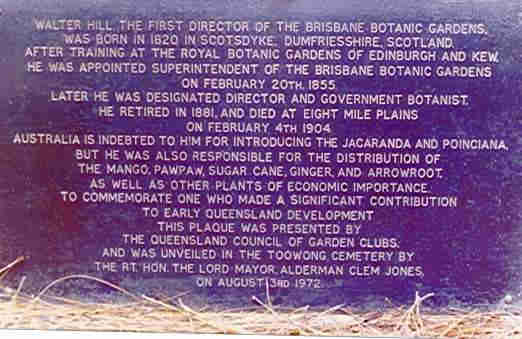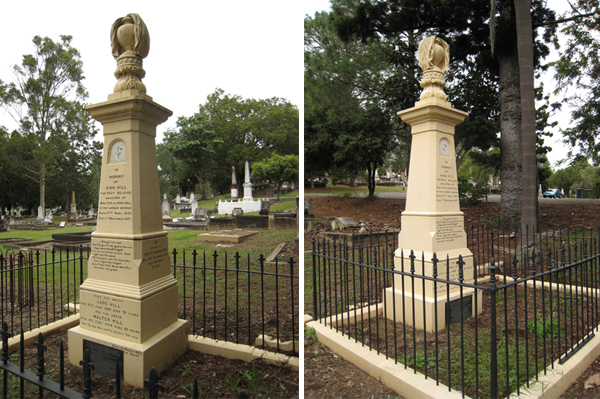March 1971: Grave Of Walter Hill
The placing of a commemorative plaque on the grave of the Brisbane Botanic Gardens will be one of our main projects this coming year. Mrs. Barry and Mrs. Richardson recently visited the grave, which is situated in Toowong Cemetery with Mr. Caulfield, present Curator.
It proved to be a most interesting afternoon, as he later took us over the proposed new botanic gardens, which undoubtedly will be extremely beautiful. The location is a perfect one, and Garden Clubs can be assured of some wonderful field days in the future observing the development of Mr. Caulfield’s exciting plans. To return to the grave (not literally of course), it is in quite good repair and condition The monument will need some restoration work on the lettering for which we will obtain quotes. The President had an interview with Mr. Mattett of the Brisbane City Council Health Dept. He expressed his delight with our interest and offer of the plaque, and indicated that the Council will assist by recommending a firm which carries out Council work of this nature, thereby reducing costs considerably. It is envisaged that the finished article will cost between $3O—$4O. The inscription will be obtained from the following history provided by Mr. Caulfield.

October 1972
The Walter Hill Ceremony

Article by Glenda Cooper – an extract from The Sunday Mail article by Jane Keogh
Botanist Walter Hill was born in Scotland in 1820. He gained experience in Kew Gardens in London and then, seeking adventure, emigrated to Australia in 1852. In 1855, Hill was appointed Curator tasked with creating Brisbane’s first Botanic Gardens. Hill inherited the old six-acre marshy market garden. He badgered the Government to extend the gardens right to the riverbank on three sides enabling a site of 25 acres and creating water vistas as well as the pleasure of waterfront strolling.
Hill planted whatever grew best in the sub-tropical climate, blending endemic species with those collected internationally. He published catalogues of the new Queensland plants and distributed them to curators all over the world, which enabled him to set up a seed and cuttings exchange system. During his term as superintendent, Hill arranged for Queensland flora and fauna to be exhibited at international exhibitions throughout the world and in return, received numerous specimens for Queensland’s benefit. He also travelled all over the state creating new species of plants.
Hill contributed to agriculture introducing mango, pawpaw, ginger, tamarind, arrowroot, cotton, mahogany and sugar cane. He also brought the Jacaranda and Poinciana trees to Queensland.
Footnote: Brisbane, Queensland and Australia owe a debt of gratitude to Walter Hill for his contribution to botany in his new country.
